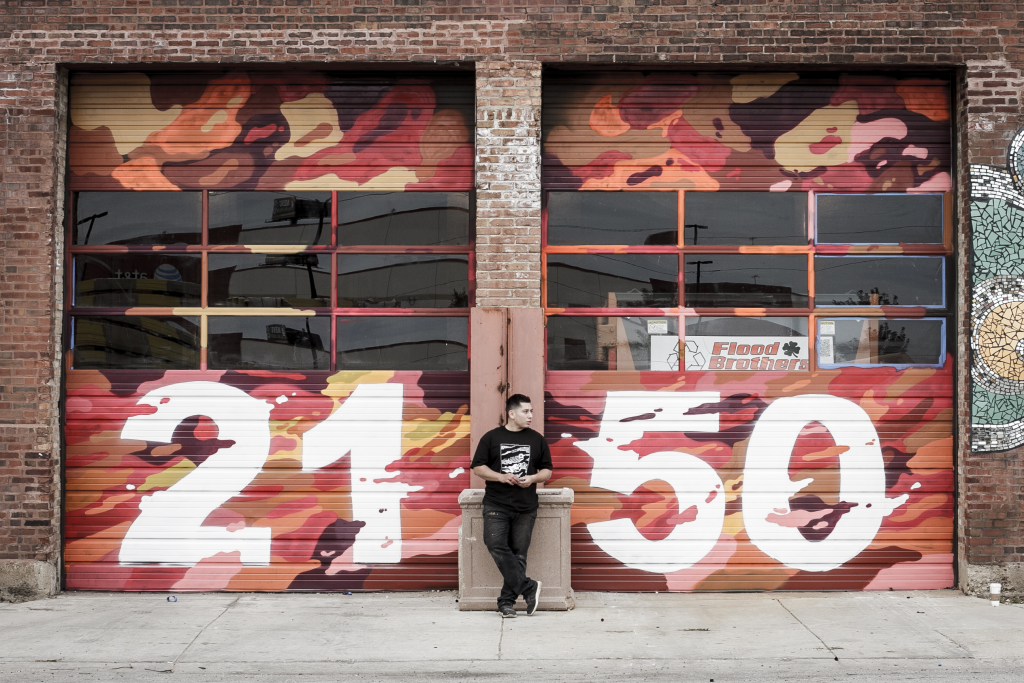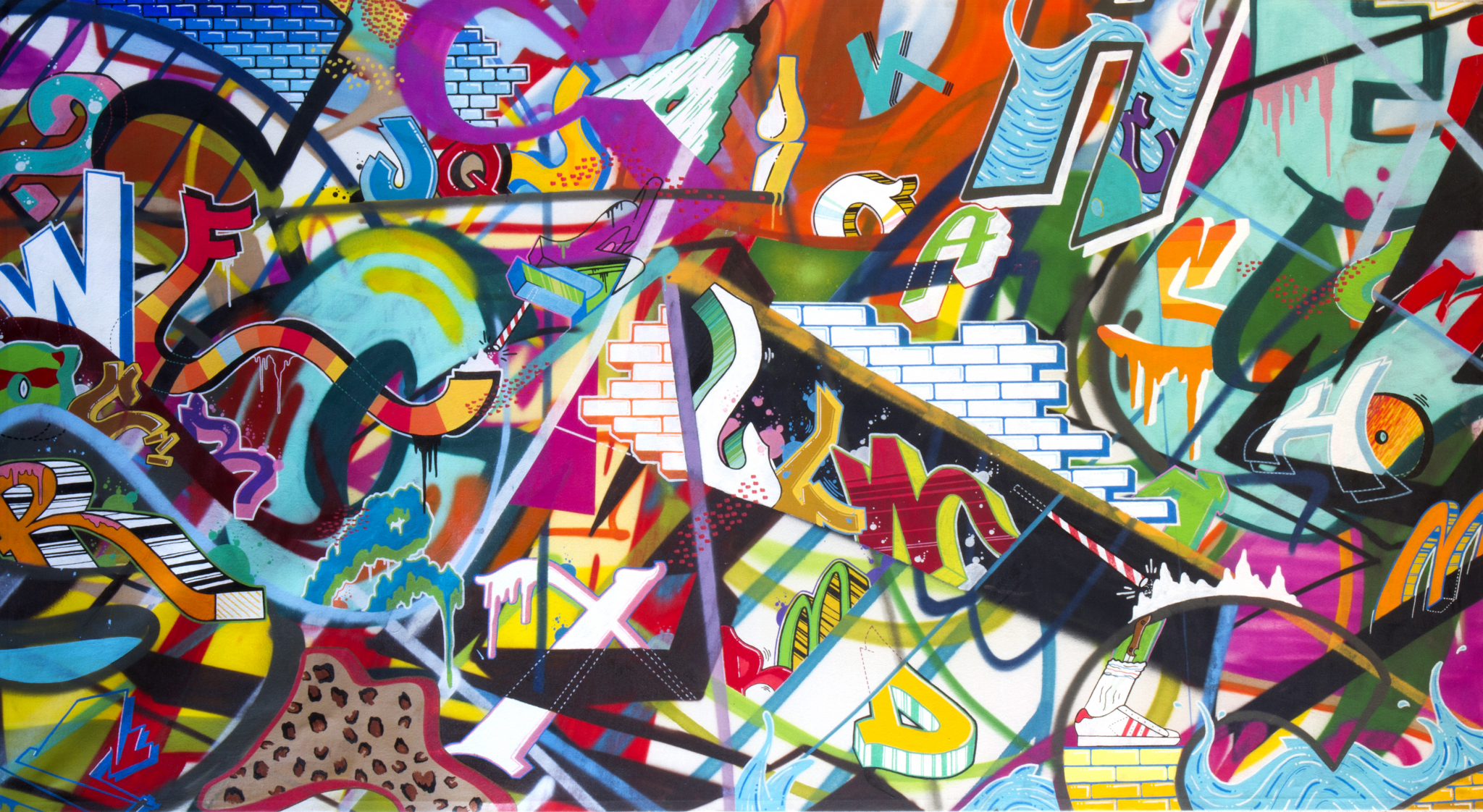Walking into Mauricio Ramirez’s studio in Lacuna Artist Lofts, it’s evident that his art is a creature with its own agency—free to jump from wall to canvas, from bicycle to CTA car, from iPhone case to shoes. With graffiti crawling out from the hanging canvases onto the walls beneath it, Ramirez’s design space is constantly changing and mutating. And with new projects, collaborations, and exhibitions in the works, it’s unlikely anything will be static for long.
Ramirez’s designs aren’t confined to the inside of the building, either; they slink out through cracks in the windows and seep out underneath the doors onto the exterior brick facade of the Lacuna space in Pilsen. An abandoned CTA car is perched outside on a heap of snow, guarding one of the side entrances to the center. Ramirez’s designs have even snuck onto the train car’s metal walls, with vibrant colors that blossom into a bright camouflage composition.
Today, Ramirez is a young and promising artist-in-residence at Lacuna. But just a few years ago he was eating, breathing, and sleeping for soccer—investing time and energy in the sport in the hopes of getting a scholarship for college. The devotion paid off, and Ramirez landed at the University of Illinois at Springfield with a soccer scholarship.
Ramirez first started playing with typography and art as a teenager, when he would sneak out with his cousins to paint graffiti on abandoned freight trains and tunnels in Chicago. This was his introduction to the world of paint, shapes, and color, but it wasn’t until college that he first got the idea to transfer the graffiti onto a canvas.
As an English major at UIS, he started to examine more closely the role of letters in shaping the way we view the world. A self-proclaimed “architect of letters,” Ramirez continues to think through the ways letters and language serve as representations of background, character, and personality, by building letters into his paintings, murals, and designs.

As we sit in his studio, surrounded by his colorful designs, Ramirez points to a twisted, bubbly “E” on one of the canvases across the room.
“You see that ‘E’?” he says. “I mean, how do I take that ‘E,’ and how do I shape it and bend it? How do I make it look like you want to take it out of the canvas? How do I play between realism and exaggeration to build it with the other letters in the painting?”
With help from mentors and friends, Ramirez learned how to stretch and frame canvases, how to prime them, and what kinds of paints to use. He started to display his work in various cafés in downtown Springfield, and slowly gained recognition from peers and professors. For a year after he graduated, he worked sanding and painting airplanes.
After moving to Chicago, he found work with Hebru Brantley’s team of artists at Lacuna. Inspired by the space’s creative energy, Ramirez started taking on more projects, joining artist Davide Nanni on some interior design assignments. Eventually, Ramirez became a full-time employee at Lacuna and now has his own studio space.
Ramirez says his successes are nothing but “lucky coins” that he managed to catch, but it’s evident that his hard work, persistence, and willingness to try new things have contributed tremendously to his accomplishments. Recently, his artwork was featured in a human-size Pac-Man maze, a creative installation for Bud Light’s “Up For Whatever” Super Bowl commercial. As part of his sponsorship with Bud Light, Ramirez was also flown out to Colorado, where he worked with other artists to paint an entire town, called “Whatever, USA,” in blue designs and murals.
Ramirez’s mainstream commercial success doesn’t stop at beer advertisements—he’s had a number of collaborations with hip-hop musicians Vic Mensa and Alex Wiley. He transformed his studio into a creative installation concert venue with Wiley, drawing crowds into Lacuna. Ramirez has even partnered with Adidas to create the design for a pair of sneakers.
“Sure, I can sell a painting here and there, but how can I really give art to the people?” Ramirez asks. “I want to transfer it to things people can use or buy so that it can really become a part of their lives.” As we’re speaking, he picks up an iPhone case. Sure enough, his characteristic vibrant strokes cover the plastic.
Ramirez is taking this design even further with his next big project: “The Garage Sale.” Like a massive Ikea floor set, he will display a wide variety of items and objects—ranging from couches and chairs to lamps and shelves—decorated with his prints. Visitors will be able to walk through the massive exhibition, choose their favorites, and buy any of the products on display.
“I hate being a salesman,” he says. “I want to transfer my work and my experiences into products that everyone can have, but I want to sell my stuff in a cool, tasteful way.”
“How can I transfer my skills to all parts of life?” Ramirez continues. “Everything can use some design and color. Even refrigerators need artwork.”
Correction February 25, 2015: Due to an editing error, an earlier version of this article misspelled the name of artist Davide Nanni.




Yes, they need to get more visual. I was just thkniing about why I dislike Twitter, and just use Facebook a lot. And it occured to me that it is the lack of visual stimulus. I’m not interested in shorty witty, smart assed comments from people I don’t know (except for Samuel L Jackson’s during the Olympics). Furthermore, Twitter is hard to use as a real communication tool, but FB’s interface makes it easy to have a decent conversation w/ someone via comments & Twitter’s doesn’t. If they make it more visually appealing and user friendly I could get into it.